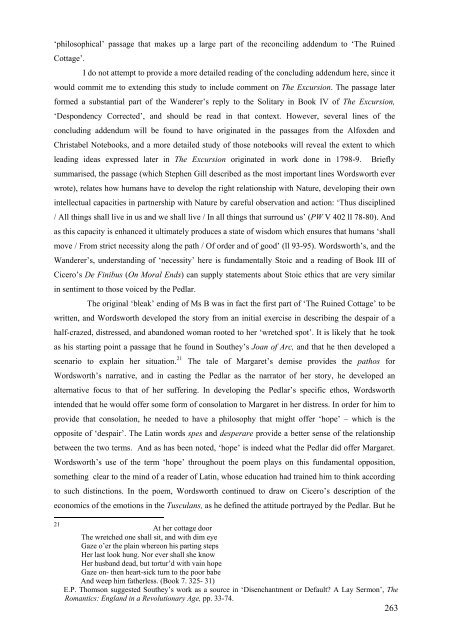Contents - ResearchSpace@Auckland - The University of Auckland
Contents - ResearchSpace@Auckland - The University of Auckland
Contents - ResearchSpace@Auckland - The University of Auckland
You also want an ePaper? Increase the reach of your titles
YUMPU automatically turns print PDFs into web optimized ePapers that Google loves.
‘philosophical’ passage that makes up a large part <strong>of</strong> the reconciling addendum to ‘<strong>The</strong> RuinedCottage’.I do not attempt to provide a more detailed reading <strong>of</strong> the concluding addendum here, since itwould commit me to extending this study to include comment on <strong>The</strong> Excursion. <strong>The</strong> passage laterformed a substantial part <strong>of</strong> the Wanderer’s reply to the Solitary in Book IV <strong>of</strong> <strong>The</strong> Excursion,‘Despondency Corrected’, and should be read in that context. However, several lines <strong>of</strong> theconcluding addendum will be found to have originated in the passages from the Alfoxden andChristabel Notebooks, and a more detailed study <strong>of</strong> those notebooks will reveal the extent to whichleading ideas expressed later in <strong>The</strong> Excursion originated in work done in 1798-9. Brieflysummarised, the passage (which Stephen Gill described as the most important lines Wordsworth everwrote), relates how humans have to develop the right relationship with Nature, developing their ownintellectual capacities in partnership with Nature by careful observation and action: ‘Thus disciplined/ All things shall live in us and we shall live / In all things that surround us’ (PW V 402 ll 78-80). Andas this capacity is enhanced it ultimately produces a state <strong>of</strong> wisdom which ensures that humans ‘shallmove / From strict necessity along the path / Of order and <strong>of</strong> good’ (ll 93-95). Wordsworth’s, and theWanderer’s, understanding <strong>of</strong> ‘necessity’ here is fundamentally Stoic and a reading <strong>of</strong> Book III <strong>of</strong>Cicero’s De Finibus (On Moral Ends) can supply statements about Stoic ethics that are very similarin sentiment to those voiced by the Pedlar.<strong>The</strong> original ‘bleak’ ending <strong>of</strong> Ms B was in fact the first part <strong>of</strong> ‘<strong>The</strong> Ruined Cottage’ to bewritten, and Wordsworth developed the story from an initial exercise in describing the despair <strong>of</strong> ahalf-crazed, distressed, and abandoned woman rooted to her ‘wretched spot’. It is likely that he tookas his starting point a passage that he found in Southey’s Joan <strong>of</strong> Arc, and that he then developed ascenario to explain her situation. 21<strong>The</strong> tale <strong>of</strong> Margaret’s demise provides the pathos forWordsworth’s narrative, and in casting the Pedlar as the narrator <strong>of</strong> her story, he developed analternative focus to that <strong>of</strong> her suffering. In developing the Pedlar’s specific ethos, Wordsworthintended that he would <strong>of</strong>fer some form <strong>of</strong> consolation to Margaret in her distress. In order for him toprovide that consolation, he needed to have a philosophy that might <strong>of</strong>fer ‘hope’ – which is theopposite <strong>of</strong> ‘despair’. <strong>The</strong> Latin words spes and desperare provide a better sense <strong>of</strong> the relationshipbetween the two terms. And as has been noted, ‘hope’ is indeed what the Pedlar did <strong>of</strong>fer Margaret.Wordsworth’s use <strong>of</strong> the term ‘hope’ throughout the poem plays on this fundamental opposition,something clear to the mind <strong>of</strong> a reader <strong>of</strong> Latin, whose education had trained him to think accordingto such distinctions. In the poem, Wordsworth continued to draw on Cicero’s description <strong>of</strong> theeconomics <strong>of</strong> the emotions in the Tusculans, as he defined the attitude portrayed by the Pedlar. But he21At her cottage door<strong>The</strong> wretched one shall sit, and with dim eyeGaze o’er the plain whereon his parting stepsHer last look hung. Nor ever shall she knowHer husband dead, but tortur’d with vain hopeGaze on- then heart-sick turn to the poor babeAnd weep him fatherless. (Book 7. 325- 31)E.P. Thomson suggested Southey’s work as a source in ‘Disenchantment or Default? A Lay Sermon’, <strong>The</strong>Romantics: England in a Revolutionary Age, pp. 33-74.263














